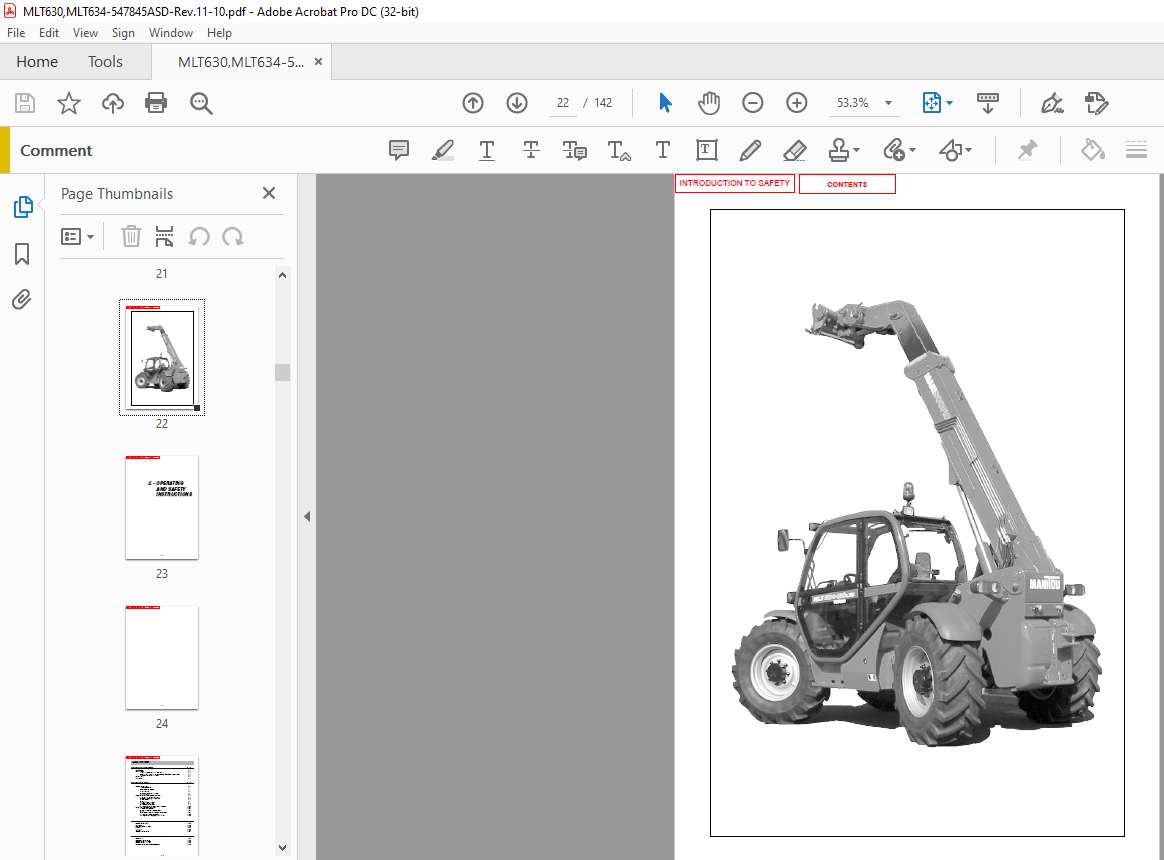Manitou MLT630 T MLT634-120 LSU Series B-E2 Operator’s Manual – PDF DOWNLOAD
IMAGES PREVIEW OF THE MANUAL:
DESCRIPTION:
Manitou MLT630 T MLT634-120 LSU Series B-E2 Operator’s Manual – PDF DOWNLOAD
ROUGH TERRAIN FORKLIFT TRUCK GENERAL SAFETY STANDARDS
STUDY THE OPERATOR/SERVICE MANUALS:
The information in this manual provides general instructions for the safe operation and maintenance of your forklift truck. This information is vital and must be clearly understood by the operator and serviceman. Study this manual and the Rough Terrain Forklift Safety Manual (part no. 422494) thoroughly and carefully before operating or servicing your forklift. Contact your dealer or Manitou North America, Inc. if you have any questions concerning your forklift, its operation, service or parts. Keep both manuals in the literature box on the forklift available for reference. If either manual becomes illegible or is missing, contact your dealer for replacements immediately. This manual cannot cover every situation that might result in an accident. It is the responsibility of the operator to always remain alert for potential hazards and be prepared to avoid them!
ADDITIONAL RECOMMENDED LITERATURE:
ANSI / ITSDF B56.6 is the national consensus standard for rough terrain forklift trucks. It contains rules about forklift safety, maintenance, safe operation, training, and supervision. Forklift owners should learn this standard and make it available for their operators, service personnel, and supervisors.
These standards can be obtained, free of charge, from the Industrial Truck Standards Development Foundation (ITSDF) on their website at www.itsdf.org. The following references are examples from the standard, addressing forklift operators:
A.) OPERATOR TRAINING QUALIFICATIONS
1.) The user shall ensure that operators understand that safe operation is the operator’s responsibility. The
user shall ensure that operators are knowledgeable of, and observe, all safety rules and practices.
2.) Create an effective operator training program centered around user company’s policies, operating conditions,
and rough terrain forklift trucks. The program should be presented completely to all new operators and
not be condensed for those claiming previous experience.
3.) Information on operator training is available from several sources, including rough terrain forklift truck manufacturers,
users, government agencies, etc.
4.) An operator training program should consist of the following:
a.) careful selection of the operator, considering physical qualifications, job attitude, and aptitude;
b.) emphasis on safety of stock, equipment, operator, and other personnel;
c.) citing of rules and why they were formulated;
d.) basic fundamentals of rough terrain forklift truck and component design as related to safety, e.g.,
in.-lb (N-m) loading, mechanical limitations, center of gravity, stability, etc.;
e.) introduction to equipment, control locations, and functions. Explain how they work when used
properly and problems when used improperly.
f.) supervise practice on operating course remote from normal activity and designed to simulate
actual operations, e.g., lumber stacking, elevating shingles to the roof, etc.;
g.) oral, written, and operational performance tests and evaluations during and at completion of the
course;
h.) refresher courses, which may be condensed versions of the primary
course, and periodic “on job” operator evaluation;
i.) understanding of nameplate data and operator instructions and warning information appearing on
the rough terrain forklift truck.
TABLE OF CONTENTS:
Manitou MLT630 T MLT634-120 LSU Series B-E2 Operator’s Manual – PDF DOWNLOAD
INSTRUCTIONS TO THE COMPANY MANAGER
THE OPERATOR
THE LIFT TRUCK
A – THE LIFT TRUCK’S SUITABILITY FOR THE JOB
B – ADAPTATION OF THE LIFT TRUCK TO STANDARD ENVIRONMENTAL CONDITIONS
C – MODIFICATION OF THE LIFT TRUCK
INSTRUCTIONS
MAINTENANCE
INSTRUCTIONS FOR THE OPERATOR
GENERAL INSTRUCTIONS
A – OPERATOR’S MANUAL
B – AUTHORIZATION FOR USE
C – MAINTENANCE
D – MODIFICATION OF THE LIFT TRUCK
E – LIFTING PEOPLE
OPERATING INSTRUCTIONS UNLADEN AND LADEN
A – BEFORE STARTING THE LIFT TRUCK
B – DRIVER’S OPERATING INSTRUCTIONS
C – ENVIRONMENT
D – VISIBILITY
E – STARTING THE LIFT TRUCK
F – DRIVING THE LIFT TRUCK
G – STOPPING THE LIFT TRUCK
H – DRIVING THE LIFT TRUCK ON THE PUBLIC HIGHWAY
INSTRUCTIONS FOR HANDLING A LOAD
A – CHOICE OF ATTACHMENTS
B – MASS OF LOAD AND CENTER OF GRAVITY
C – N/A
D – HORIZONTAL ATTITUDE OF THE LIFT TRUCK
E – TAKING UP A LOAD ON THE GROUND
F – TAKING UP AND LAYING A HIGH LOAD ON TIRES
MAINTENANCE INSTRUCTIONS OF THE LIFT TRUCK
GENERAL INSTRUCTIONS
MAINTENANCE
LUBRICANT AND FUEL LEVELS
HYDRAULIC
ELECTRICITY
WELDING
WASHING THE LIFT TRUCK
IF THE LIFT TRUCK IS NOT TO BE USED FOR A LONG TIME
INTRODUCTION
PREPARING THE LIFT TRUCK
PROTECTING THE I.C. ENGINE
PROTECTING THE LIFT TRUCK
BRINGING THE LIFT TRUCK BACK INTO SERVICE
IDENTIFICATION OF THE LIFT TRUCK
CHARACTERISTICS
FRONT AND REAR TIRES
DIMENSIONS AND LOAD CHARTS
INSTRUMENTS AND CONTROLS
TOWING PIN AND HOOK
DESCRIPTION AND USE OF THE OPTIONS
ORIGINAL MANITOU SPARE PARTS AND EQUIPMENT
FILTERS CARTRIDGES AND BELTS
LUBRICANTS AND FUEL
SERVICING SCHEDULE
A – DAILY OR EVERY 10 HOURS SERVICE
B – EVERY 50 HOURS SERVICE
C – EVERY 250 HOURS SERVICE
D – EVERY 500 HOURS SERVICE
E – EVERY 1000 HOURS SERVICE
F – EVERY 2000 HOURS OF SERVICE
G – OCCASIONAL MAINTENANCE
INTRODUCTION
PICKING UP THE ATTACHMENTS
A – ATTACHMENT WITHOUT HYDRAULICS AND HAND LOCKING DEVICE
B – ATTACHMENT WITHOUT HYDRAULICS AND HYDRAULIC LOCKING DEVICE (OPTION)
C – HYDRAULIC ATTACHMENT AND HAND LOCKING DEVICE
D – HYDRAULIC ATTACHMENT AND HYDRAULIC LOCKING DEVICE (OPTION)
VIDEO PREVIEW OF THE MANUAL:
PLEASE NOTE:
- This is not a physical manual but a digital manual – meaning no physical copy will be couriered to you. The manual can be yours in the next 2 mins as once you make the payment, you will be directed to the download page IMMEDIATELY.
- This is the same manual used by the dealers inorder to diagnose your vehicle of its faults.
- Require some other service manual or have any queries: please WRITE to us at [email protected]










